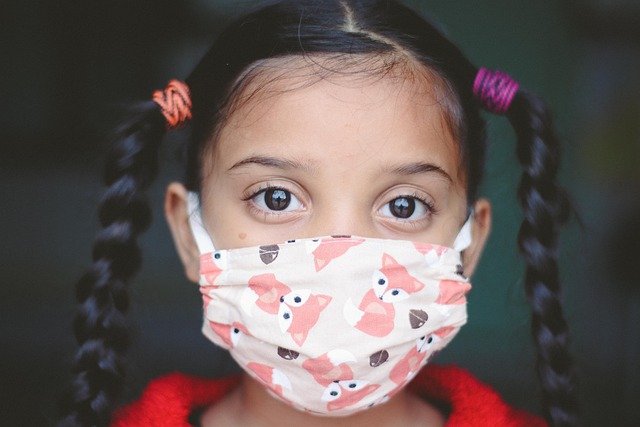
As children around the country return to school, the debate whether or not children should wear masks in school continues. In addition, the issue of whether kids wearing masks delays development has become a hot-button topic for many.
Some parents believe their children are being negatively impacted. They suggest that kids are unable to read social cues or see expressions and thus, they do not want their children or anyone else wearing them.
But those who want to prevent their unvaccinated kids from contracting COVID state that developmentally, children are just fine, even when they and everyone else around them is masked.
What does the latest research say about children, mask wearing, emotion recognition and child development? Read on to learn more.
Babies and Infants
 Research has shown that infants as young as 27 weeks old begin to recognize facial expressions of emotion. In addition, a series of studies have shown that babies between the ages of 5 to 7 months recognize facial expressions of happiness, sadness, fear and surprise.
Research has shown that infants as young as 27 weeks old begin to recognize facial expressions of emotion. In addition, a series of studies have shown that babies between the ages of 5 to 7 months recognize facial expressions of happiness, sadness, fear and surprise.
A key part of learning to communicate for a child is watching the faces, mouths, and expressions of the people closest to them. Babies and young children study faces intently, so the concern about masks covering the face is understandable. However, there are no known studies that use of a face mask negatively impacts a child’s speech and language development.
Interestingly, visually impaired children develop speech and language skills at the same rate as their peers. In fact, when one sense is taken away, the others may be heightened. Young children will use other clues provided to them to understand and learn language. They will watch gestures, hear changes in tone of voice, see eyes convey emotions, and listen to words.
Some people worry that although young infants shouldn’t wear face masks themselves, they will be subjected to developmental delays from not being able to see others’ full faces.
Yet experts say that babies and toddlers can get all the face time they need in the home with family members who aren’t wearing face masks.
By providing dedicated time to converse with your child without screens or other interruptions, children should reach their expected milestones.
READ: 4 Tips to Improve Infant Emotion Recognition Skills
Children age 3-5
 While essential emotion processing is evident in infants, early childhood is considered a critical period for the development of understanding emotions and emotion processing.
While essential emotion processing is evident in infants, early childhood is considered a critical period for the development of understanding emotions and emotion processing.
In a report entitled “Masking Emotions: Face Masks Impair How We Read Emotions” researchers demonstrated that face masks influence the human ability to infer emotions by observing facial expressions.
Specifically, a mask obstructing a face limits the ability of people of all ages to infer emotions expressed by facial features, but the difficulties associated with the mask’s use were significantly pronounced in children ages 3 and 5 years old.
The researchers’ findings are of essential importance; they suggest that we live in a time that may potentially affect the development of social and emotion reasoning. In addition, young children’s future social abilities should be monitored to assess the true impact of the use of masks.
One proposed solution is to design devices for personal protection that allows visibility of the lower part of the face, especially all environments important for developing social and interaction skills in children, such as in education or rehabilitation. This is especially important for children suffering from sensory or cognitive deficits.
Children age 7-13

In research conducted by Ashley Ruba and her team at the University of Wisconsin–Madison, researchers used our own JACFEE/JACNeuF images (available here) to conduct their study.
They showed more than 80 children, ages 7 to 13, photos of faces displaying sadness, anger or fear that were unobstructed, covered by a surgical mask, or wearing sunglasses.
As reported by UWM, the kids were asked to assign an emotion to each face from a list of six labels.
The results? The kids were correct about the uncovered faces as often as 66 percent of the time, well above the odds (about 17 percent) of guessing one correct emotion from the six options.
With a mask in the way, they correctly identified sadness about 28 percent of the time, anger 27 percent of the time, and fear 18 percent of the time.
The researchers suggest if children can do better than guessing at emotions even with a mask in place, they’re likely to do even better in real-life situations. It all adds up to kids growing in their emotional capabilities, even if some of their interactions with others are happening through face coverings.
Says lead researcher Ruba:
“I hope this settles some nerves. Kids are really resilient. They’re able to adjust to the information they’re given, and it doesn’t look like wearing masks will slow down their development in this case.”
For more on how children learn about emotions, watch this lecture by Dr. Ruba below:
Tips to Communicate with Kids while Wearing a Mask
Maybe you’re in a profession where wearing a face mask is required. What are some helpful tips to better communicate with children while wearing a face mask?
The American Academy of Pediatrics has some helpful tips to be a better communicator:
